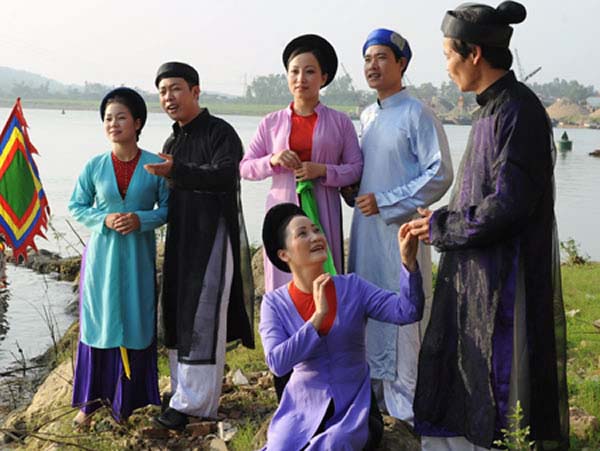(TITC) - Vi and Giam folk songs of Nghe Tinh occupy an important position in the cultural and spiritual life of people of Nghe An and Ha Tinh provinces (abbreviated as Nghe Tinh). This is a type of art that has long lasting life, imbued character and manner of Nghe Tinh people and is the precious heritage in Vietnamese cultural treasure.

Characteristics of Vi and Giam Folk Songs of Nghe Tinh
Originated from two Nghe Tinh folk forms of Vi singing and Giam singing, Vi and Giam folk songs are practiced in almost daily activities of local people such as lulling children to sleep, cultivating rice in the fields, rowing boats, making conical hats…
Vi songs are named according to different performing contexts, such as ‘rice-seedling transplanting Vi’, ‘conical-hat making Vi”, or ‘weaving Vi’. Vi is performed in three styles: non-alternating, alternating and ‘organized group’ singing. Giam is performed in two styles: recitative and alternating boy and girl call-and-response songs. There are various types of Giam songs known as ‘lullaby Giam’, ‘narrative Giam’, ‘advice Giam’.
Vi and Giam lyrics use the specific dialect and linguistic idioms of the Nghe Tinh region and practitioners sing with the particular singing voice of Nghe Tinh people. The lyrics utilise various poetic forms and meters including a pair of six and eight syllable lines, and variants of six and eight syllable lines for Vi and five syllable lines for Giam. Vi and Giam are sung separately, but they are also sung alternately.
Outstanding values of Vi and Giam Folk Songs of Nghe Tinh
Vi and Giam folk songs are strongly attached to lifestyles and customs of Nghe Tinh people. They have a powerful vitality in contemporary life and have long been handed down, transmitted, preserved and promoted. Vi and Giam folk songs are an artistic medium for expressing the ideas and spirit of the Nghe Tinh people at the same reflecting truthfully changes in social life.
Besides, Vi and Giam folk songs also contribute to educating traditional moral values including respect for parents, loyalty, care and devotion, call upon the people to oppose oppression and injustice. Joining in Vi and Giam folk singing is the opportunity to strengthen community coherence.
Vi and Giam folk singing is the open space for everyone, regardless of their age, occupation and religion. Performances are undertaken to ensure equality and mutual respect among communities, groups and individuals and contribute to sustainable development of society.
Vi and Giam folk songs are also the source of inspiration for many contemporary composers and have provided musical motifs for numerous well-known popular songs and operatic works that are well liked by the public.
Practicing Vi and Giam Folk Songs of Nghe Tinh
Vi and Giam folk songs are practiced widely in Vietnamese community in Nghe An and Ha Tinh provinces. According to an inventory undertaken by Viet Nam Institute of Culture and Arts Studies in 2013, now there are 75 Vi and Giam folk song groups with about 1,500 members, of which includes 803 master practitioners in 260 villages (168 villages in Nghe An Province and 92 villages in Ha Tinh Province).
With unique and outstanding values, on 27 November 2014, in the 9th session of Intergovernmental Committee for the Safeguarding of the Intangible Cultural Heritage of UNESCO in Paris (France), Vi and Giam folk songs of Nghe Tinh was officially recognized as Intangible Cultural Heritage of Humanity.
Thu Giang